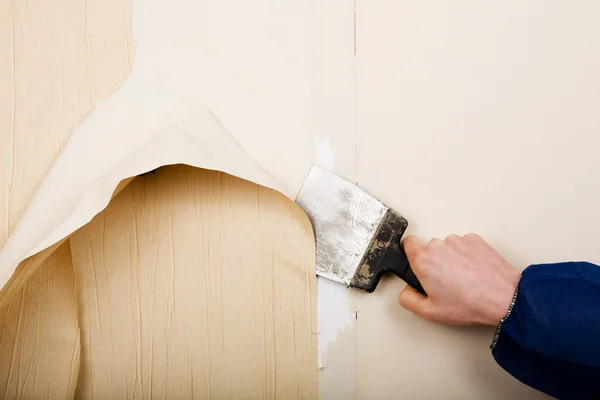Return to Wallpaper Removal
Wallpaper: Pros & Cons

Decorating has gone through multiple phases, at times gravitating towards wallpaper or back to painted wall surfaces. The advantage of wallpaper, in addition to the visual element, is that it’s a very durable surface that can take mild abrasions and hand traffic. It can also hide minor wall imperfections at times.
We have seen some absolutely beautiful and classic wallpaper materials that have stood the test of time and served their purpose well for many years. But, there are other times when the paper just needs to go!
We often get requests for wallpaper removal from our clients. It’s a task that, if you’ve personally done it, creates a smirk, a shaking of the head, and the comment, “Not a fun job.” Even when done correctly, it is a job that requires patience and a methodical approach to keep from damaging the walls.
Variables To Be Considered
There are many factors that come into play that help us understand which pieces of the puzzle we have when assessing a project that requires wallpaper removal. Whether you are using a solution, warm soapy water, or a steamer, moisture applied in a calculated way is the key to removing wallpaper. Keeping the paper wet just long enough to soften the glue, but not too long to ruin the substrate, is important to discern as you begin. We often will try a few different areas as a litmus test, timing how long it takes for the water to penetrate the paper, soften the glue, and find the best approach.
Plaster Walls
What year was the home built? In upstate New York, we have generally found (depending on the builder) that homes built up until the 1950s or 1960s had rock lath or plaster walls that are very durable and do not have a paper face like drywall does. These surfaces can oftentimes take far more punishment from the scraping and wetting of the wallpaper to soften the glue. There are often fewer variables with this wall surface as far as the paper removal itself, but because of the vintage, there may be settling or cracks lurking beneath the wallpaper. These are often not discernible when the paper was in place.
Drywall
When it comes to homes built in the 1960s where drywall was used, it’s a different story. Although this wall surface will not quite take the punishment that plaster walls can handle as described earlier, there are additional variables that can be a huge benefit or make wallpaper removal a challenge. If the wall was correctly primed or sized prior to the wallpaper being installed, it should remove without needing too much repair. Oftentimes the room may have even had one or two coats of finish paint prior to deciding to paper the room, which gives added layers of protection to the drywall for the wallpaper removal process.
Installation
The final variable is really the person who installed the wallpaper and what type of paper they installed. Some wallpaper products will separate, leaving the backing behind prior to wetting anything down. This is ideal as you can see your nemesis and soften the glue very quickly. This makes wallpaper removal much easier. If the paper will not separate from its backing, there are a few other tricks that will need to be implemented. We prefer not to use scoring tools, as this often leaves many tiny holes in random circular patterns in the drywall, causing unnecessary repairs. We prefer to use coarse grit sandpaper to just scuff the wallpaper face so that moisture will penetrate the shiny surface into the paper backing. If using this method, you will need to look for a darkening of the paper as you apply moisture and keep an eye on how much time is necessary to see the results you’re looking for. It often takes 10 or 15 minutes to work a 10 to 15 ft.² area, applying moisture maybe once every 1 to 2 minutes. Once again, being methodical and patient is key.
We mentioned earlier that the installer of the wallpaper also plays a key role in what you’re up against. On occasion, we will come across someone who cut through the wallpaper to match a pattern or cut through an upper corner when trimming excess wallpaper material, which now all needs to be repaired prior to painting. It’s not the end of the world if this has taken place, but it can very easily add an average of $200- $400 to the wall prep needed prior to painting.
Ready to Transform Your Space?
As you can see there are many factors that are to be considered when successfully removing wallpaper without too many unnecessary repairs. However, in the end, you can completely transform a room that you may not have enjoyed being in into a room you cannot do without! Are you considering removing wallpaper from a room in your home? Give us a call to see if we’re a good fit for the needs of your family.